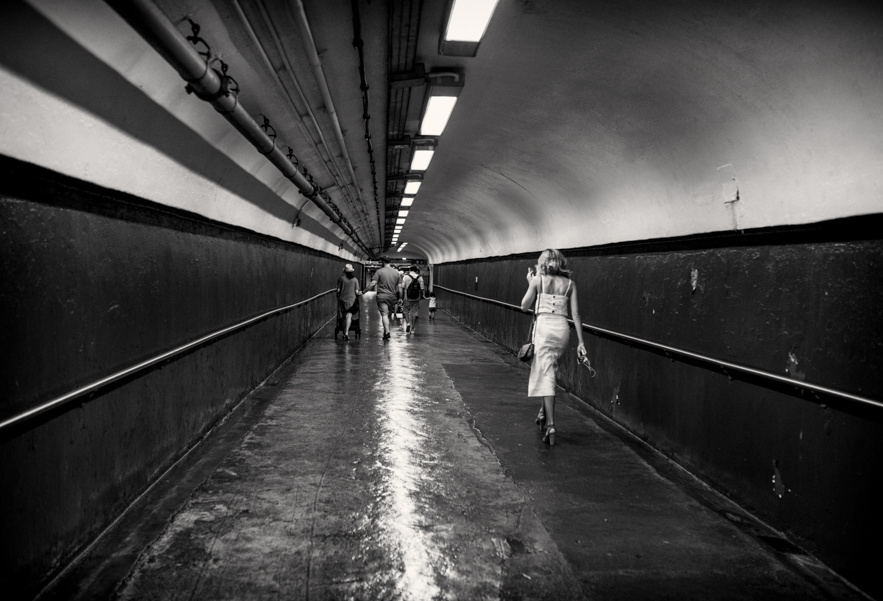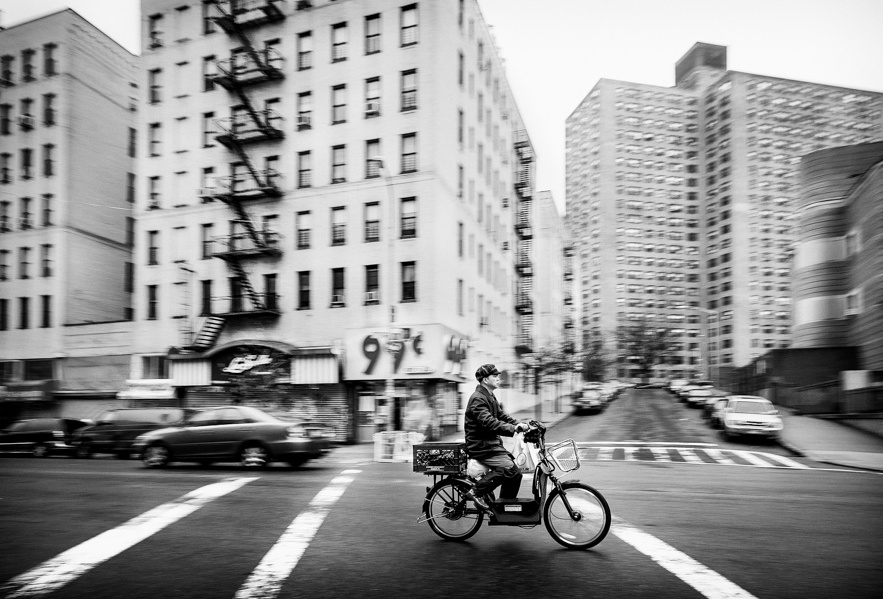Sean Alonzo Harris’s “Voices in Our Midst” is a beautiful exhibition of portraits and street photography. It’s also a challenging show in terms of context, assumptions and content. Of the two dozen images, virtually all feature figures in (to me and Harris, at least) familiar places, with only a couple in which the leading figures are not persons of color.
From a photographic perspective, the issue of identity is essentially inconsequential. But insofar as Harris’s two main settings are Portland and New York City, it certainly has an effect on how we respond to what we see.
As a photographer, Harris is a masterful craftsman, but he downplays this aspect of his work behind the logic of street photography – which is generally defined by its observational spontaneity and snapshot sense. While they might seem like opposed modes, street photography has much in common with plein air painting – the cornerstone of traditional Maine art. Both modes are driven by a sense of place and urgent on-site observation. The obvious contrast is that one is a patently urban mode, while the other is fundamentally rural. That so many of the major players who helped define “Maine art” had one foot Down East with the other in New York is a deep current, but it is probably better illustrated when discussing artists like John Marin, Marsden Hartley, Berenice Abbott, George Bellows, Robert Henri or more contemporary artists such as Alex Katz, Bernard Langlais or Lois Dodd.

“The Story of Me #6,” Portland, 2010.
What first struck me about “Voices” was the elegance and visual intelligence of Harris’s images. “The Story of Me,” for example, is a 2010 black-and-white facial portrait of a young black woman in a hijab. We see her upturned face from slightly below. In terms of tone, texture and lighting, it is a masterwork by any reasonable measure, beautiful, subtly sculptural and striking. “Rennie Harris Project #18” is an extraordinarily different image: Rather than a person in traditional garb, the subject is a dancer who was performing at the Bates Dance Festival in 2009. His gaze is direct and intense. He wears a dark, contemporary top and his hair is knotted into tight, prickly spikes. He is no less beautiful than the woman in the hijab, but while she looks up and away dreamily, aspirationally, the dancer stares down the camera and the whole scene quivers with an energy that jars it slightly out of focus, as if his personal dynamic tension was impossible to contain on full-focus film.
While Harris’s first images are portraits, much of the show contains scenes of parks and public places as well as the scenes seen on city streets. One struck my own personal mystic chords of memory: the long subway tunnel exit at Dyckman Street in Manhattan, the northern terminal of the A train line, near where I used to live. The bustling subjects are diverse, but we are drawn to a striking (white) woman in heels and a dress, striding almost like a sprinter up the underground incline.
This tilt sets the stage for Harris’s sense of street photography. With digital photography, we are now used to the idea – far different from our recent (but seemingly distant) past of Polaroids and snapshots – that any and every image should be straightened (via Photoshop, etc.) to have the horizon line fully flat. Harris not only rejects this, but uses the tilted lines of buildings, horizons and structures to set his compositions in motion. His feel for tilt is fundamental to his formal logic.
Another image of Dyckman Street features a man of Asian descent on an electric bike delivering what we assume to be Chinese food. The fuzzy distortion of the image leaves the delivery man as the clear center of focus, while the writhing twist of the bent-angled buildings only supports his sense of speedy delivery. At first glance, the figure comes across as an anonymous glance, but a longer look brings him into focus as a regular – and therefore, recognizable – member of the neighborhood. He is the local – and when we sense that, perhaps, so are we.
Harris’s other food service worker is quite different: He has stepped out onto Times Square to sneak a smoke. He is fleeting and, quite intentionally, anonymous. Harris’s tilting him forward plays to the angle of his white apron, with a different sense of quickness. In a flick and a flash, he’ll be gone.
Harris’s best tilt is more internal than architectural. In “Chalk Line and Straw Hat,” the “chalk line” is a reference to the figure’s pinstripe jacket, seen from the back. The title furthers our eye to texture and fashion, bringing in both the visual textures of the straw hat but also the intentionality of its angled tilt. (I think it was Frank Sinatra who, talking about hats, said “angles are attitudes.”) What pushes the image beyond Harris’s (now) expected brilliance is the alignment of the hat with the blurred baubles New Yorkers will recognize as the lights the city uses in the scaffolding placed over sidewalks during construction (well, mostly reconstruction) of the buildings above. Here, Harris shows his old-school taste for the soupy graininess associated with quick-shutter photography – and I salute him for it.

“Kennedy Park Project – Got This,” Portland, 2017.
While Harris’s aesthetic abilities and observational skills comprised my first take on his work, I had to work to wrap my head around his images of Portland parks – particularly the images from his “Kennedy Park” series, a place only a few hundred yards from the gallery. In the context of the images of New York and the preponderance of people of color, my favorite works in the show, the Kennedy Park images, cast an urban rather than a local – Maine – feel. I have to admit this was probably (OK, undoubtedly) more about my own perceptions than Harris’s intentions, even though I once lived near Dyckman Street and worked in Harlem while Harris has lived even longer in the Portland area than I have. Nonetheless, it’s a loaded and not-inaccurate observation. If the Portland park images featured mostly white kids, they would not have conveyed (to me, at least) the same “urban” feel. To be clear, the only challenge I felt here was the one I put to myself: Harris is not caught up in the same questions, or, at least, not in the same way.
I think a more obvious approach to thinking about “Voices in Our Midst” is to focus on the Kennedy Park and Portland scenes. For example, there is a pair of images that presents two almost identical pairs of people in New York and Portland that will undoubtedly startle viewers when they realize which is New York and which is Portland. But after trying to wrap my head around so many different philosophical and ideological possibilities of “Voices in Our Midst,” again and again I came back to the simple fact that Harris is one of Maine’s most satisfying and excellent photographers. Ultimately, the success of “Voices in Our Midst” wells from its photographic and formal accomplishments, combined with Harris’s fundamental humanism.
Freelance writer Daniel Kany is an art historian who lives in Cumberland. He can be contacted at:
dankany@gmail.com
Send questions/comments to the editors.







Comments are no longer available on this story